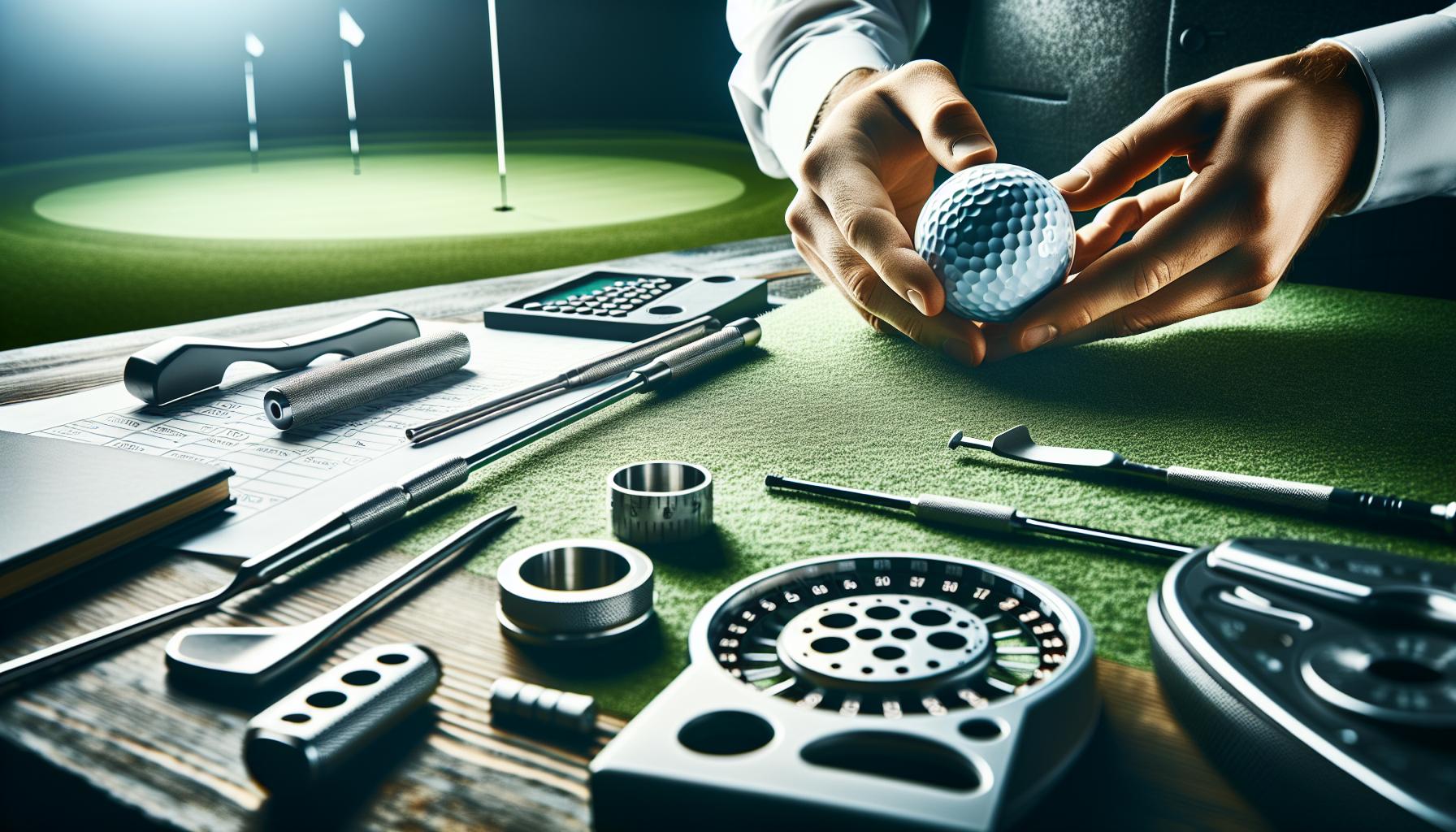Did you know that around 43% of your total strokes in golf can come from putting? Understanding how to putt effectively can make or break your game. “How to Putt the Golf Ball? Green Reading & Technique” is a guide designed to sharpen your skills on the greens. Whether you’re a novice looking to lower your score or a seasoned player aiming for precision, mastering the art of putting involves more than just a steady hand; it requires keen observation, confident technique, and an understanding of the course.
Every putt challenges your ability to read greens, gauge distances, and execute the perfect stroke. By honing these skills, you can transform what often feels like a daunting aspect of the game into a powerful advantage. Dive into the essentials of putting and unlock the tools you need to elevate your performance, ensure every stroke counts, and ultimately enjoy your golf game even more.
How to Read the Green Like a Pro

Understanding how to read the green effectively is an essential skill for any golfer aiming to lower their scores. This ability allows you to better predict the trajectory and speed of your putt, helping you to adapt your strategy accordingly. Start by mastering the basics: always begin your green reading process from behind the hole. This vantage point allows you to see the overall slope and determine how the ball will break as it approaches the cup.
With the overall slope in mind, you should then assess the distance between your ball and the hole. An effective method is the “clock face” approach-imagine the hole as the center of a clock. This will help you visualize the angles and assess any slopes you may need to factor into your putt. Additionally, watching the grain of the grass can provide crucial insights. Grass growing into the putt slows down roll, while grass growing away speeds it up. Make sure to analyze the grass direction closely, which often aligns with the sun’s location.
Another key strategy is to identify any undulations on the green before taking your shot. Walk around the area, looking for subtle changes in elevation that might not be immediately noticeable. Use your feet to feel the slope: standing behind the ball, tilt your body slightly to assess the angle. Furthermore, consider the weather conditions and how they affect the greens: moisture can dramatically change the speed and break. Applying these techniques consistently will elevate your game, transforming you into a confident putter capable of reading greens like a pro.
Essential Techniques for Perfect Putting
To elevate your putting game, mastering a series of essential techniques is crucial. Understanding the mechanics of your stroke, ensuring quality contact with the ball, and managing distance control are foundational to sinking more putts. For instance, employing a consistent pre-shot routine can help you streamline your focus and reduce anxiety, allowing you to concentrate on the mechanics rather than overthinking the outcome. Consider dedicating time to develop your setup, aiming your putter correctly, and finding your ideal stance-elements that interplay to enhance your overall effectiveness on the green.
A vital aspect of perfect putting is practicing your stroke mechanics. One effective technique is the “Lead Foot Only Drill,” which involves putting while balancing primarily on your lead foot. This encourages stability and promotes a pendulum-like motion that can improve your rhythm and tempo. Make sure to practice with both short and long putts to gain confidence across all distances. Understanding that a smooth, consistent stroke often yields better results than an aggressive approach is key to developing finesse in your putting.
Another indispensable technique involves focusing on distance control. To achieve this, visualize different lengths of putts and how much force is required to reach the hole. One effective exercise is to place various targets around the hole at incrementally increasing distances, practicing your lag putting. This drill not only builds muscle memory but also enables you to feel the distance control necessary for different greens.
Lastly, while physical techniques are crucial, it’s important to cultivate a mentally resilient mindset. Visualizing your successful putts and rehearsing your stroke in your mind can significantly enhance your confidence. Remember that every exceptional putt begins with the mental approach-believing you can make the shot is half the battle. By honing these essential techniques and integrating them into your practice regimen, you’ll transform your putting skills and significantly lower your scores.
Understanding the Physics of a Putt

Understanding the physics behind putting is crucial for golfers looking to enhance their performance on the green. Each putt is a delicate interplay of force, angle, and surface interaction that can significantly affect the trajectory and outcome of the ball. The objective is to strike the ball in such a way that it rolls toward the hole with optimal speed and precision, taking into account the variable surfaces of the greens.
When you address the ball, consider that the force applied to the putter can be broken down into two components: magnitude and direction. The magnitude refers to how hard you plan to hit the ball, while direction pertains to the angle of your putter’s face at contact. This angle must align with your target to ensure the ball follows the correct path. Using tools like launch monitors can help analyze your putting stroke data, measuring key parameters such as clubhead speed and angle of attack, leading to insights that can refine your technique.
Additionally, the friction between the ball and the green plays a pivotal role in how your putt behaves. Different green speeds, often rated on the Stimpmeter, directly influence the amount of force required. On faster greens, a lighter touch may suffice, while slower greens may demand more force. Understanding how grass conditions and moisture levels affect friction can enable you to adjust your approach. Moreover, employing various golf balls, such as those with multi-layer constructions designed for feel and control, can enhance performance by optimizing how the ball interacts with the clubface during impact.
Lastly, the angle of inclination on slopes and breaks is fundamental when predicting the ball’s path. Gravity will cause the ball to break toward lower elevations, making green reading an essential skill. Utilizing an understanding of the physics of angles can boost your confidence in making adjustments before each stroke. By mastering these elements and employing specific drills, such as practicing on different green slopes and speeds, golfers can dramatically improve their putting skills and overall game.
Common Mistakes to Avoid When Putting

The difference between sinking that crucial putt or leaving it short can often hinge on seemingly minor mistakes that plague even seasoned players. Most golfers are unaware of their habits that contribute to inconsistent putting performance. Here’s a look at common pitfalls that can undermine your success on the greens.
One prevalent mistake is failing to read the green properly. Players often neglect to assess the slope, grain, and texture of the surface, which can drastically affect the ball’s path. Take the time to walk around the hole from multiple angles; this not only helps in visualizing the break but also in gauging the speed required for different green conditions. Remember, a well-read putt can mitigate other factors such as stroke mechanics and grip.
Another frequent error is poor alignment. Even the most adept golfers can find their putter face misaligned at address, leading to inconsistent results. Before each stroke, ensure that your body and the putter face are lined up correctly with the target. Utilize alignment aids on your putter or practice with alignment sticks to reinforce the correct stance and aim. Accurate alignment creates a solid foundation for an effective stroke.
In addition, many players tend to rush their putting stroke under pressure. This hurried approach often results in inconsistent touch and feel, leading to mis-hits and missed opportunities. Focus on a smooth, rhythmic stroke instead of a fast-paced one. Take a deep breath, establish your routine, and execute your putt confidently without rushing. Incorporating a pre-shot routine can help settle nerves and improve routine consistency.
Lastly, grip pressure is crucial yet often overlooked. Many golfers do not realize that their grip should be light and relaxed. Holding the putter too tightly can lead to tension in your arms and shoulders, restricting fluidity and control during the stroke. Practice maintaining light grip pressure throughout your swing. A relaxed grip allows for better touch, providing a delicate feel necessary for precise putting.
By avoiding these common mistakes-improper green reading, misalignment, rushed strokes, and excessive grip pressure-you can enhance your putting prowess and lower your scores. Stay aware of these elements on the greens, and make adjustments as needed to cultivate a more effective and consistent putting game.
The Importance of Grip and Stance
The grip and stance are foundational elements in successful putting; they serve as the bedrock upon which all other techniques are built. An improper grip can lead to a chain reaction of flaws, affecting alignment, stroke mechanics, and ultimately, results on the green. Achieving the right grip is about finding a balance between control and comfort. A grip that is too tight can introduce tension into your arms and shoulders, diminishing the fluidity of your stroke, while a grip that is too loose risks losing control of the putter.
To find the ideal grip, focus on the following steps:
- Placement: Hold the putter with your dominant hand first; ensure that your palms face each other.
- Pressure: Maintain a light grip, similar to holding a small bird-firm, yet gentle.
- Alignment: Ensure that the putter shaft runs along the lifeline of your dominant hand for optimal control.
Equally significant is your stance. A balanced stance allows for a stable base, enabling a consistent and repeatable stroke. Your feet should be shoulder-width apart, providing a solid foundation while allowing for proper weight distribution. Bend slightly at the knees, keeping your posture athletic yet relaxed. Your body weight should lean slightly forward towards the ball, which helps you maintain a forward momentum during the stroke.
When setting up, take note of the following:
- Align your eyes: Your eyes should be directly over the ball to help with alignment and depth perception.
- Foot position: Ensure your feet are parallel to your intended target line to promote consistency.
- Ball position: Place the ball roughly in line with the heel of your front foot for optimal angle and contact.
By prioritizing your grip and stance, you establish a consistent platform from which to execute your putting strokes. Master these elements, and you will find an increased level of confidence and control on the greens, translating to lower scores and more successful rounds.
Tools and Equipment for Better Putting

Selecting the right tools and equipment can greatly enhance your putting performance, making the art of putting both more efficient and enjoyable. Not only does having the right putter matter, but choosing the correct golf ball and accessories can influence your success on the green. With advancements in technology, modern putters are designed with various head shapes, materials, and features to cater to all playing styles and preferences. For example, mallet putters offer superior stability and alignment, while blade putters provide greater feel and feedback for those who prioritize touch.
When it comes to golf balls, the construction plays a pivotal role in how the ball behaves on the green. A ball’s cover material-whether urethane or surlyn-affects its spin rate and feel. Urethane-covered balls, for instance, generally provide a softer feel and enhanced spin control, ideal for players seeking precision on delicate putts. In contrast, surlyn covers tend to be more durable and suited for those who might prioritize distance over feel. Understand your preferences and playing style when selecting a golf ball; visiting your local golf pro shop for ball fitting sessions can provide insights on what aligns best with your game.
Essential Accessories
Adding the right accessories can further elevate your putting game. Consider the benefits of a high-quality putting mat for practice at home, which allows you to work on your alignment and distance control without requiring access to a green. A putting aid, such as an alignment stick, can help maintain proper form and ensure your putter’s face is square at impact. Additionally, using a stroke coach that detects swing path and tempo can provide immediate feedback, helping you refine your technique systematically.
Choosing the right equipment is not just about personal preference but also accommodating varying green conditions. With tools tailored to your style and quality gear to practice effectively, you can confidently step onto any green and observe significant improvements in your putting game. Investing in the right tools coupled with ongoing practice will lead to enhanced feel, touch, and consistency in your putting, translating to lower scores and a more enjoyable golfing experience.
Practicing Your Putt: Drills and Tips
To achieve success on the greens, honing your putting skills through dedicated practice is essential. By focusing on specific drills and tips, you can improve your accuracy, consistency, and confidence. A well-structured routine can help you develop muscle memory and the ability to read greens effectively.
Start by incorporating the “Circle Drill” into your practice regimen. Position a series of balls in a circle around the hole, about three feet away, with an equal distance between each ball. Putt each ball into the hole while maintaining a steady stance and grip. This drill not only enhances your precision but also simulates pressure situations, as sinking consecutive putts instills confidence in your ability to make short, clutch putts during a round.
Another effective technique is the “Gate Drill”, which focuses on your putter’s stroke path. Create a small gate using two alignment sticks or tees, placed slightly wider than the putter head. Practice stroking the ball through the gate without touching the boundaries. This exercise promotes a straight back and through stroke while helping you understand the importance of a proper follow-through.
Incorporating distance control drills is also crucial for improving your putting game. One simple drill involves selecting a target at varying distances (e.g., three, six, and nine feet) and establishing a scoring system to track how many attempts it takes you to sink a set number of putts from each distance. This exercise not only gauges your feel for longer putts but also emphasizes knowing when to adjust your grip and stance based on the distance.
Finally, spend time practicing your alignment and stance with the “Mirror Drill.” Use a mirror to reflect your posture and the path of your putter as you practice. Ensure your shoulders, hips, and feet are aligned parallel to your target line. This visual feedback allows you to correct your form and reinforce the right body mechanics, contributing directly to improved performance on the course.
Incorporating these drills into your routine will help you develop a solid foundation for your putting game. Consistent practice paired with focused drills will enhance your skills, enabling you to read greens effectively and execute putts with greater confidence and accuracy. Remember, the key to effective putting lies not only in technique but also in practice and mental preparedness.
Advanced Techniques: Feel and Touch
To master the art of putting, developing a keen sense of feel and touch is essential. This specialized skill allows a golfer to gauge the speed, distance, and break of a putt with extraordinary precision. The ability to differentiate between light taps and firm strokes can dramatically affect your performance on the green. By honing these techniques, players can navigate the complexities of varied green conditions and improve their overall putting game.
One influential method to enhance your feel is through the use of varied practice drills that focus on touch. For instance, create a series of distance putts ranging from short taps (1-2 feet) to longer attempts (10-20 feet) and practice these in sets. Pay attention to how much force you apply to each shot based on distance; the more you practice, the better you’ll get at instinctively knowing how hard to hit the ball. Additionally, consider using a putting green with different grass types or slopes to familiarize yourself with how each surface affects your touch and feel.
Another crucial aspect to developing feel is the integration of visualization techniques. Before you putt, take a moment to visualize the ball rolling towards the hole. Imagine the path it will take, the interplay of speed and slope, and the moment it drops into the cup. This mental rehearsal not only boosts confidence but also enhances your touch by creating a sensory experience that prepares you for the real shot ahead.
Finally, experimenting with different putter grips can greatly impact your feel. A lighter grip can offer more sensitivity to feedback from the clubface, while a firmer grip may provide added control during your stroke. Trying various grip styles-such as the overlap, interlock, or the claw-allows you to discover which offers you the best combination of feel and accuracy. Keep in mind that consistency in your grip will lead to more predictable results, but a slight adjustment in technique based on your unique preferences can fine-tune your touch on the greens.
By emphasizing these advanced techniques, you cultivate a nuanced touch and feel that transforms your putting skills. Consistency, through persistent practice paired with effective visualization and grip experimentation, will elevate your putting performance to new heights.
Mental Strategies for Confident Putting
A strong mental game is crucial for any golfer looking to enhance their putting performance. Psychological factors can influence even the most skilled players, making mental strategies essential for confident and effective putting on the green. One effective approach is to develop a pre-shot routine that focuses on calming the mind and building confidence. This routine can involve visualization techniques where you imagine the putt rolling into the hole, which not only boosts your positive outlook but also helps you mentally rehearse the exact motion and speed required.
Another powerful strategy is to use positive affirmations or cues that encourage a focused, ready state before every putt. Phrases like “smooth and steady” or “trust your stroke” can reinforce your commitment to the shot and alleviate any anxiety. Practicing deep breathing techniques can also aid in maintaining composure, particularly in high-pressure situations. By taking a few deep breaths to center yourself prior to your putt, you can drastically reduce performance anxiety and enhance your concentration.
Embracing visualization feeds into the concept of “presence,” which is about being in the moment while putting. Rather than overthinking the mechanics of your swing or the potential outcome, aim to maintain focus on the target line and your intended line of the putt. This presence not only reduces distractions but also allows for a more intuitive and relaxed putting stroke.
Understanding that mishits or bad rounds are part of the game can further reinforce mental resilience. Reminding yourself that every golfer misses putts, and using them as learning experiences instead of opportunities for self-criticism builds a more robust mental approach over time. With practice, these mental strategies will become second nature, empowering you to face each putt with confidence, no matter the circumstances.
Putting Under Pressure: Tips for Success
In golf, the ability to perform under pressure can often determine the outcome of a round or a tournament. Mastering the mental and technical aspects of putting when the stakes are high is essential for every golfer aiming to lower their scores or enhance their competitive edge. One proven method to combat pressure is developing a consistent pre-putt routine that can anchor your focus. This routine should involve a series of actions you perform before every putt, such as assessing the line, visualizing the path of the ball, and taking a deep breath to ground yourself in the moment. By automating this sequence, you create a mental space that is less affected by external distractions, allowing you to concentrate solely on executing the putt.
Another critical aspect is the visual and tactile preparation before the stroke-practice, and familiarity with varying green conditions. Spend time not just reading the slope and break of the putt but also acclimatizing yourself to different greens. Understanding how the grass type affects ball roll, such as how Bermuda grass can create a faster putt compared to bentgrass, will give you a better chance of success.
During high-pressure situations, it’s vital to empty your mind of distractions and concentrate on a “target-focused” mentality. Instead of fixating on the outcome or worrying about missing the putt, focus solely on the target line and rhythm of your stroke. This physical and mental separation from the result can help decrease anxiety and increase performance consistency. One effective technique is to visualize your intended line-imagine the ball rolling smoothly into the hole, which can help reinforce a positive mindset.
Lastly, it can be beneficial to embrace the challenge of pressure instead of shying away from it. Top athletes often find motivation in high-pressure situations, viewing them as opportunities to rise to the occasion. Acknowledging that pressure can enhance performance rather than hinder it is a game-changer for any golfer. Training under simulated pressure, such as practicing crucial putts with teammates watching or during competitive play, can help develop this resilience and improve your performance when the stakes are at their highest.
Evaluating Your Putting Performance
To improve your putting performance, a comprehensive evaluation process is essential. Analyzing not just the outcomes of your putts but also the mechanics behind each stroke can provide valuable insights that lead to significant improvement on the green. One of the primary tools in your evaluation arsenal is to track your statistics, which can help identify patterns in your putting performance. For instance, consider metrics such as your putt conversion rate from various distances, the average number of putts per round, and the percentage of putts made from inside five feet. By systematically recording these stats over multiple rounds, you’ll begin to see where your strengths lie and where there’s room for improvement.
It’s also crucial to evaluate the technical aspects of your putting stroke. Use video analysis or enlist a playing partner to help observe your setup, stroke path, and follow-through. Are you maintaining a steady head position throughout your putt? Is your follow-through consistent? Pay close attention to your grip pressure and alignment; even minor inconsistencies can lead to missed putts. Additionally, creating a checklist can aid in these evaluations:
- Grip: Is your grip pressure consistent and appropriate for your technique?
- Alignment: Are you properly aligned towards your target line?
- Stroke Path: Is your stroke straight back and straight through, or does it arc?
- Follow-through: Are you completing your stroke with a balanced finish?
Implementing these evaluations consistently will allow you to build a clear picture of your strengths and weaknesses.
Finally, consider using advanced technology to aid in your performance evaluation. Devices such as portable launch monitors or putting simulators can provide real-time feedback on your stroke mechanics and help you practice under conditions similar to an actual game. These tools can measure key metrics like stroke speed, face angle at impact, and even roll accuracy, which are invaluable for targeted improvement. Over time, this holistic approach to will not only enhance your skills but also boost your confidence on the green, enabling you to make more informed decisions in critical moments.
Building a Personalized Putting Routine
Building a successful putting routine is a game-changer for any golfer looking to improve their performance on the green. At the heart of this routine lies consistency-the more predictable your process, the more reliable your outcomes. A well-structured putting routine helps to develop muscle memory, reduce anxiety, and enhance focus, allowing you to approach every putt with the confidence needed to sink it.
Start by establishing a pre-putt routine that works for you. This should include key elements such as selecting the right club, evaluating the distance and slope, and managing your breathing. For instance, take a moment to visualize the ball rolling in your mind before approaching your shot. Walking through the routine on each putt ensures that you remain calm and collected, lessening the distractions of the course or the pressure of important moments.
Incorporating practice drills into your routine can greatly enhance your skills. For example, the “gate drill” involves setting up two alignment sticks or tees a few inches apart to create a narrow “gate” through which you must putt the ball. This exercise focuses on your stroke path and promotes better alignment. Additionally, using varied lengths and breaks can simulate on-course scenarios, ensuring you’re prepared for a range of angles and distances.
Tracking your progress through a dedicated journal or app can also provide insights into your performance. Assess metrics like putts made from different ranges, average distance to the hole after a putt, or even how you felt mentally before and after each round. Evaluating this data regularly allows you to refine your routine, address weaknesses, and celebrate improvements, reinforcing your commitment to becoming an exceptional putter.
Overall, the key to a personalized putting routine is to adapt various strategies and techniques that fit your unique style. By emphasizing consistency, practice, and self-reflection, you can unlock new levels of performance and elevate your game.
Faq
Q: How can I improve my green reading skills for putting?
A: To enhance your green reading skills, practice observing the slope and grain of the grass before putting. Use a visual aid like a putting guide, and always assess the break from multiple angles. Familiarize yourself with the specific greens on your course, as each will have unique characteristics.
Q: What are the best drills to practice my putting technique?
A: Some effective drills include the ‘Gate Drill’ for improving aim and the ‘1-2-3 Drill’ to focus on distance control. Set up markers to create a gate for your putter head to practice straight strokes. Incorporate short putts to build confidence before extending your range.
Q: When should I use a firmer stroke versus a softer stroke when putting?
A: Use a firmer stroke for longer putts or when hitting uphill, as it helps maintain speed and accuracy. A softer stroke is ideal for delicate downhill putts or breaking putts where touch is crucial to avoid overshooting the hole.
Q: How do I choose the right putter for my style of play?
A: Selecting the right putter involves testing different head shapes and weights to match your stroke style-straight back and through vs. an arc. Consider the grip size and feel as well. Visit a fitting center for personalized advice and recommendations.
Q: What mental strategies can help improve my putting performance?
A: Techniques such as visualization and positive reinforcement can significantly boost your mental game. Visualize the ball’s path to the hole before the stroke, and maintain a positive mindset to reduce anxiety while putting.
Q: How do environmental factors affect putting performance?
A: Wind, humidity, and temperature can all impact green speed and ball behavior. Be mindful of these conditions; for example, stronger winds may require a lower stroke to minimize the ball’s drift, while humid conditions might slow down the green.
Q: What should I focus on during a putting practice session?
A: Concentrate on consistency, distance control, and alignment during your practice. Begin with short putts to build confidence, gradually increasing the distance. Aim to simulate on-course scenarios to prepare for various putting challenges.
Q: How can I evaluate my putting performance effectively?
A: Keep a putting journal to track your performance metrics, such as made putts, distances, and hole locations. Reviewing your patterns over time helps identify strengths and areas for improvement, allowing for targeted practice sessions.
To Conclude
Mastering the art of putting goes beyond just technique; it requires a keen understanding of green reading and practice. By incorporating the strategies discussed in “How to Putt the Golf Ball? Green Reading & Technique,” you can elevate your short game and lower your scores. Don’t wait to implement these tactics-start practicing today and watch your confidence grow with every putt.
For further refinement of your skills, check out our in-depth guides on “Common Putting Mistakes” and “Essential Putting Drills.” If you’re curious about enhancing your overall game, visit our resource center for helpful tools and tips. Remember, improving your putting is a continuous journey, and every step counts. Share your experiences in the comments below and connect with fellow golfers who are on the same path.
We hope you found this guide valuable. By focusing on your putting strategy, you’re taking a significant step towards becoming a better golfer. Sign up for our newsletter to stay updated on the latest techniques and insights in golf, and explore our product recommendations to find the right gear for your game. Keep practicing, and let’s take your putting skills to the next level!

